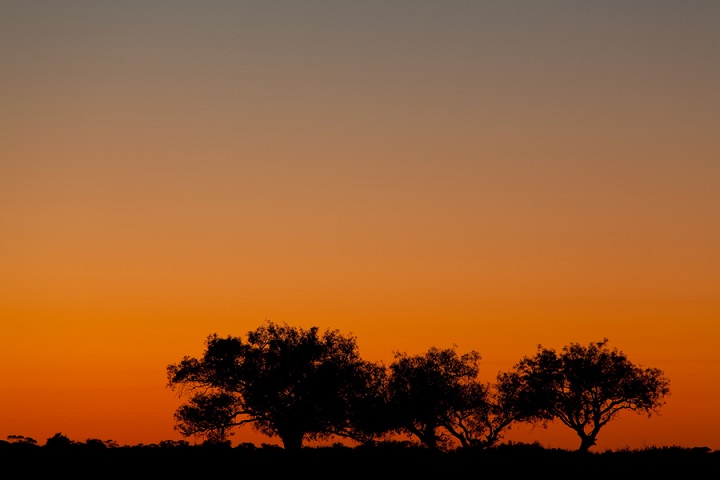Now let the TRUTH prevail. Mungo Man was here long before the current Aboriginies migrated from New Guinea.
Mungo Lady and Mungo Man
How do we know how old they are?

Rosewood trees at dawn. Photograph © Ian Brown
Dating the Past is a complex area of science that continues to advance. All dating methods have shortcomings and degrees of inaccuracy, and the age of Mungo Lady and Mungo Man has been controversial from the beginning.
Before the remains were discovered, scientists thought that Aboriginal people had been in Australia for perhaps 20,000 years, while many Aboriginal people saw themselves as being here forever.
Early estimates of the age of Mungo Man ranged from 28,000 years to 32,000 years. Then in 1999 new methods estimated Mungo Man to have lived some 62,000 years ago, a radical conclusion that was at odds with what was known about human migration across the globe.
In 2003 Harvey Johnston and Professor Jim Bowler brought together a panel of experts to try and settle the debate. Using evidence from a range of optically stimulated luminescence dating methods and four different laboratories, the scientists were able to reach an agreed age.
Both Mungo Man and Mungo Lady were 40,000 and up to 42,000 years old. That is where the science stands at present.
This research extends far beyond mere academic interest. Non-indigenous Australians too often have a desperately limited frame of historical reference. The Lake Mungo region provides a record of land and people that we latter day arrivals have failed to incorporate into our own Australian psyche. We have yet to penetrate the depths of time and cultural treasures revealed by those ancestors of indigenous Australians.
Jim Bowler, geologist
Who was Mungo Man?

Emu footprints. Photograph © Ian Brown
About 42,000 years ago, Mungo Man lived around the shores of Lake Mungo with his family. A time of abundance in the Willandra Lakes system was drawing to a close, but he could still hunt many species of game, including some of the soon-to-be-extinct megafauna. Mungo Man cared for his Country and kept safe the special men's knowledge. By his lore and ritual activity, he kept the land strong and his culture alive.
When he was young Mungo Man lost his two lower canine teeth, possibly knocked out in a ritual. He grew into a man nearly 1.7m in height. Over the years his molar teeth became worn and scratched, possibly from eating a gritty diet or stripping the long leaves of water reeds with his teeth to make twine. As Mungo Man grew older his bones ached with arthritis, especially his right elbow, which was so damaged that bits of bone were completely worn out or broken away. Such wear and tear is typical of people who have used a woomera to throw spears over many years.
Mungo Man reached a good age for the hard life of a hunter-gatherer, and died when he was about 50. His family mourned for him, and carefully buried him in the lunette, on his back with his hands crossed in his lap, and sprinkled with red ochre. Mungo Man is the oldest known example in the world of such a ritual.
Mungo Man was around 50 years of age and the condition of arthritis was so advanced that he would not have been able to fully extend his arm or turn his hand properly. It is easy to picture him sitting, slowly rubbing the ancient elbow in front of his fire on a cold ice age night.
Steve Webb, anthropologist
http://www.visitmungo.com.au/who-was-mungo-man

